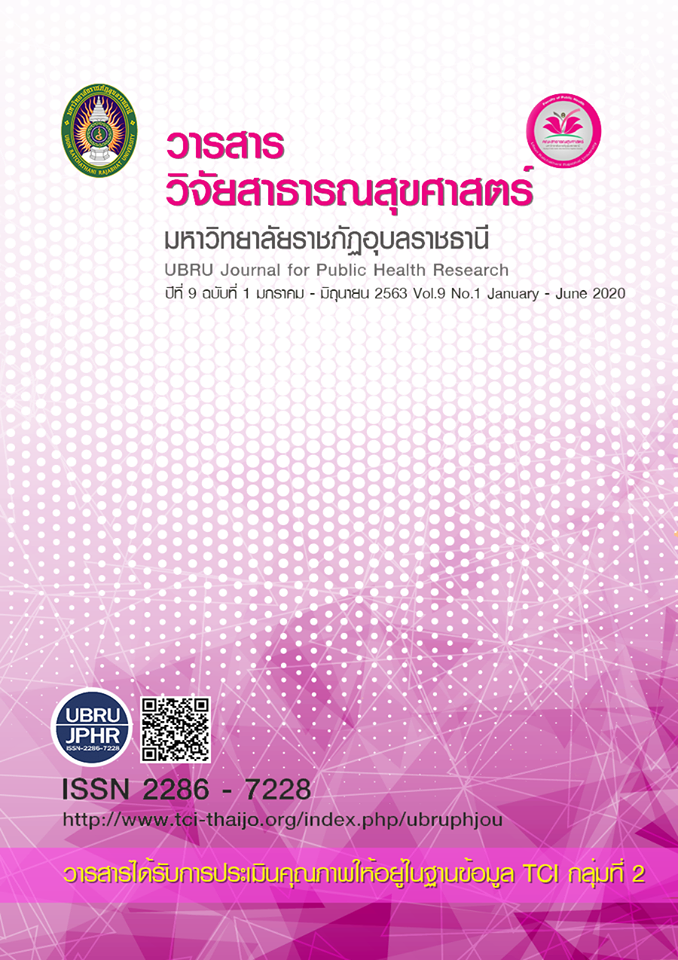การใช้กระบวนการ 5A เพื่อปรับพฤติกรรมการสูบบุหรี่ในคลินิกบริการ โรงพยาบาลส่งเสริมสุขภาพตำบลปทุม
คำสำคัญ:
กระบวนการ 5A’s, พฤติกรรมการสูบบุหรี่บทคัดย่อ
การศึกษาครั้งนี้มีวัตถุประสงค์เพื่อศึกษาผลการปรับพฤติกรรมการสูบบุหรี่ในคลินิกบริการโดยใช้กระบวนการ 5A’s เป็นการศึกษาเชิงพรรณนาแบบภาคตัดขวางในกลุ่มผู้สูบบุหรี่ที่มีอายุ 15 ปีขึ้นไปและเข้ารับบริการให้คำปรึกษาเลิกบุหรี่ในโรงพยาบาลส่งเสริมสุขภาพตำบลปทุม ระหว่างเดือน ตุลาคม 2558 ถึง กันยายน 2559 จำนวน 60 ราย เก็บรวบรวมข้อมูลโดยใช้แบบสัมภาษณ์ข้อมูลทั่วไปและพฤติกรรมสูบบุหรี่ แบบประเมินการติดนิโคติน ภาพพลิกบุหรี่กับสุขภาพ การให้คำปรึกษาตามกระบวนการ 5A’s และประเมินการเลิกบุหรี่ด้วย stage of change ทุก ๆ 3 เดือน (1, 3, 6 เดือน) วิเคราะห์ข้อมูลโดยใช้สถิติเชิงพรรณนา ผลการศึกษาพบว่า อาสาสมัครส่วนใหญ่เป็นเพศชาย (ร้อยละ 90) อาสาสมัครทุกรายไม่ติดนิโคติน ส่วนใหญ่สูบบุหรี่เพราะความเคยชินและเพื่อเข้าสังคม ผลการติดตามภายหลังการบำบัดครบ 1 เดือน มีอาสาสมัครเลิกบุหรี่ได้ 25 ราย (ร้อยละ 41.66) เป็นผู้ป่วยเรื้อรังและสมาชิกร่วมบ้าน 16 ราย ลดจำนวนการสูบบุหรี่ 32 ราย สูบบุหรี่เท่าเดิม 3 ราย ภายหลังการบำบัดครบ 6 เดือน มีอาสาสมัครเลิกบุหรี่ได้ 21 ราย(ร้อยละ 35.0) และกลับไปสูบบุหรี่ซ้ำ 4 รายเนื่องจากสูบบุหรี่ตามเพื่อนและมีภาวะเครียดในครอบครัว ปัจจัยที่ส่งเสริมให้เลิกบุหรี่ได้สำเร็จต่อเนื่องคือ สุขภาพของตนเองและครอบครัวและค่าใช้จ่ายในการซื้อบุหรี่ สรุปการใช้กระบวนการ 5A’s ในสถานบริการปฐมภูมิสามารถค้นหาแรงจูงใจและปรับเปลี่ยนพฤติกรรมการสูบบุหรี่ได้มากขึ้น และยังช่วยเสริมสร้างสัมพันธภาพที่ดีต่อชุมชน ดังนั้น บุคลากรและอาสาสมัครสาธารณสุข ควรได้รับการอบรมเพิ่มทักษะความรู้กระบวนการ 5A’s เพื่อปรับพฤติกรรมการสูบบุหรี่ในคลินิกบริการได้อย่างมีประสิทธิภาพ
เอกสารอ้างอิง
กรองจิต วาทีสาทกกิจ. (2559). คู่มือการรักษาโรคเสพติดยาสูบสำหรับพยาบาล. นนทบุรี: มณปรียา กราฟฟิค.
บุษริน เพ็งบุญ. (2557). การช่วยเลิกบุหรี่แบบการให้บริการจุดเดียวเบ็ดเสร็จในคลินิกเรื้อรัง. วารสารพยาบาล. 63(1).
ดุษฎาภรณ์ วิสาพรม ศิวะรัญญา พละศักดิ์ สลินนา ศรีชาลี น้องเล็ก คุณวราดิศัย. (2557). การศึกษาพฤติกรรมและความตั้งใจในการเลิกบุหรี่ของ ผู้ป่วยโรคจิตเวช โรงพยาบาลพระศรีมหาโพธิ์. วารเภสัชศาสตร์ อีสาน Isan Journal of Pharmaceutical Sciences.9 (ฉบับพิเศษ).
ผ่องศรี ศรีมรกต จรรยา ใจหนุน ปุณยนุช สนามทอง ยุพิน หงส์ทอง ประทีป แสวงดี และอรสา อัครวัชรางกูร. (2556). ประสิทธิภาพของการช่วยเลิกบุหรี่โดยพยาบาลในประเทศไทย. วารสารพยาบาล. 62(1).
สุทัศน์ รุ่งเรืองหิรัญญา รณชัย คงสกนธ์. (2556). ตำราบุหรี่และยาสูบพิษภัยการดูแลรักษาและป้องกัน. เครือข่ายวิชาชีพแพทย์ในการควบคุมการบริโภคยาสูบ(แพทยสมาคมแห่งประเทศไทย). ฉบับปรับปรุง. นครปฐม: สินทวีกิจ พริ้นติ้ง.
อรสา พันธ์ภักดี. (2558). แนวปฏิบัติการพยาบาลเพื่อช่วยเลิกบุหรี่:คู่มือการให้คำแนะนำการช่วยเลิกบุหรี่ สู่งานประจำ.พิมพ์ครั้งที่ 4 ฉบับปรับปรุงครั้งที่ 1. สำนักพิมพ์สื่อตะวัน.
ดาวน์โหลด
เผยแพร่แล้ว
รูปแบบการอ้างอิง
ฉบับ
ประเภทบทความ
สัญญาอนุญาต
เนื้อหาและข้อมูลในบทความที่ลงตีพิมพ์ในวารสารวารสารวิจัยสาธารณสุขศาสตร์ มหาวิทยาลัยราชภัฏอุบลราชธานี ถือเป็นข้อคิดเห็นและความรับผิดชอบของผู้เขียนบทความโดยตรงซึ่งกองบรรณาธิการวารสาร ไม่จำเป็นต้องเห็นด้วย หรือร่วมรับผิดชอบใดๆ
บทความ ข้อมูล เนื้อหา รูปภาพ ฯลฯ ที่ได้รับการตีพิมพ์ในวารสารนี้ ถือเป็นลิขสิทธิ์ของวารสารฯ หากบุคคลหรือหน่วยงานใดต้องการนำทั้งหมดหรือส่วนหนึ่งส่วนใดไปเผยแพร่ต่อหรือเพื่อกระทำการใดๆ จะต้องได้รับอนุญาตเป็นลายลักอักษรณ์จากบรรณาธิการวารสารนี้ก่อนเท่านั้น


